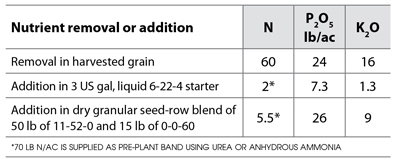
Features
Micronutrients
Seed & Chemical
Liquid starter fertilizer rates too low
November 30, 1999 By Dr. Tom Jensen Northern Great Plains Director International Plant Nutrition Institute (IPNI). *
 Starter fertilizer is usually applied close to the seed
Starter fertilizer is usually applied close to the seedStarter fertilizer is usually applied close to the seed, so that after germination and during early growth the seedling will have access to a source of fertilizer nutrient that will encourage improved growth. Starter fertilizers are usually composed of a low rate of nitrogen (N) and a moderate rate of phosphorus (P). They may be formulated to include potassium (K), sulphur (S) and some micronutrients, depending on soil supply and crop need. Phosphorus is the main component of starter fertilizers because it is important to root development, and improved root growth helps the crop get off to a good start.
Specialized formulations of liquid starter fertilizer became popular in corn production because, under high yield corn production, the higher relative per acre rates of fertilizer (e.g., 200 lb N; 100 lb P2O5; 70 lb K2O; and possibly 40 lb S) have traditionally been broadcast and incorporated prior to planting. Placement of all the pre-plant fertilizer close to the corn seed-row adversely affected germination, due to ammonia toxicity or fertilizer salt damage. However, placing a liquid starter fertilizer (e.g., a 6-22-4 N-P2O5- K2O formulation) applied at 3 US gal/ac, using a retrofit liquid fertilizer kit on existing corn planters, supplied lower rates (i.e., 2 lb N, 7.3 lb P2O5, and 1.3 lb K2O/ac) and was found to be beneficial to early seedling growth.
Because of the success of liquid starter fertilizers in corn production it is often thought that they will be of benefit in small-grain cereals and broadleaf crops planted in narrower rows. It has been suggested that use of a liquid starter fertilizer could replace traditional applications of seed-row-applied granular fertilizer or liquid fertilizer blends. In much of the Northern Great Plains of North America the majority of P fertilizer has already, for decades, been applied as a seed-row application, primarily in the form of mono-ammonium phosphate (11-52-0) but also as liquid ammonium poly-phosphate (10-34-0) some areas. This application method functions both as a starter and as a season-long P source. For example, for a target yield of 40 bushels per acre of spring wheat, traditionally a 65 lb/ac blend of 11-52-0 (50 lb product) and potash (0-0-60 at 15 lb product) has been used. This practice supplies rates of N, P, and K that are safe for germinating seeds. Additional N fertilizer is usually applied as a pre-plant band, or as a side-band at planting, using urea (46-0-0) or anhydrous ammonia (82-0-0) at a rate of about 70 lb N/ac.
The question is whether or not a liquid starter formulation such as 6-22-4, applied in the seed-row at a rate of 3 US gal/ac, is as effective as the traditional seed-row blend described above. It is important to compare the rates of N, P, and K applied relative to the harvested grain nutrient removal. The table below compares nutrient removal in a 40-bushel-per-acre wheat crop, as well as the nutrient additions for the dry granular blend and starter liquid fertilizer described above.
The nutrients supplied in the traditional dry granular blend plus the separately banded N are similar to the wheat crop nutrient removals, except for the K, but the dominant loam to clay-loam soils of the Northern Great Plains tend to be high in plant-available K. The liquid starter practice, along with the separately banded N, supplies only roughly one-third as much P. This practice is probably adequate for early seedling needs. However, in order to better match crop P removals for the whole season, either the liquid starter fertilizer needs to be applied at a three-fold increased rate or additional P needs to be applied using a different source.
If a grower who has been using the traditional seed-row fertilizer blends decides to switch over to using the lower P rate liquid fertilizer starter system, there is a possibility that plant-available P levels in soils will decline. This will not happen in one growing season, but most likely will be observed over three to five years. The best way to monitor this is to have soil samples taken and analyzed regularly (e.g., annually or biannually) and if soil test P levels begin to decline, applications of P fertilizer should be increased to better match crop removals.
*Reprinted from IPNI Plant Nutrition Today.